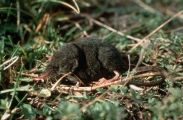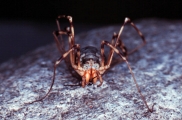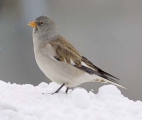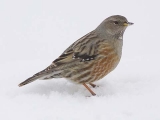 |
|
|
|
|
|
We can differentiate between two food chains of insectivores:
|
The food supply for insectivores in alpine meadows is rich and diverse. About 12 g/m² dry mass of insects were found. Of this amount, 95 % belong to the soil macrofauna, mainly earthworms (Lumbricidae). Above ground, the dominant arthropods are enchytraeids, which amounted to 60% of the individuals found. Among the dominant macroarthropod orders are thrips (Thysanoptera), cicadas and aphids (both Homoptera). |
1 - Alpine shrews are the main insectivores in alpine meadows. (135K) |
|
2 - Arthropod predator harvestmen (Opiliones) depend on external food from wind blown insects. Photo: R. Kaufmann (100K) |
In boulder fields and snow fields no humus or vegetation is present to host arthropod preys. Thus, the diversity of predators is all the more astonishing. The wind plays an important role in supplying food to the alpine zone. Many insects from lower altitudes are transported by the wind to higher elevations. Although the amount of biomass entry is difficult to measure and depends on different meteorological factors there are some data available for the Swiss Alps. One study has revealed a biomass of arthropods collected on snowfields of 44 mg dryweight per 1000m ² per day, from March to July. Among These was a remarkably high percentage of flying insects (56% Homoptera, 27% Diptera, 7% Hymenoptera) and also a remarkable abundance of predators (3% Araneae, 2% Coleoptera). Diptera are known to play an important role in high alpine ecosystems, but the homopteres and hymenopteres in the samples must have been transported to the collection site by the wind. |
| Besides the invertebrate predators, it is mainly the birds that depend on the windblown insects on snowfields. For high alpine species like the snowfinch (Montifringilla nivalis) or the alpine accentor (Prunella collaris), snowfields are the main foraging habitat and nestlings are often fed by arthropod fallout. An abundance of fallout and the easy visibility of insects against the white background allow for efficient forage. On the other hand, arthropods on snowfields often are smaller and of lower quality than prey from the surrounding alpine tundra and the unpredictability of fallout availability is a disadvantage for snowfield foragers. |
|
3a and b - Snowfinch
(Montifringilla nivalis)(left) and alpine accentor (Prunella
collaris)(right) forage mainly on arthropod fallout on snowfields.
Photo: D. Newell (20K and 67K) |
|
|
|
Antor RJ (1995) The importance of arthropod fallout on snow patches for the foraging of high-alpine birds. Journal of Avian Biology 26(1):81-85. |
29 August 2011 |
||
| |
||



